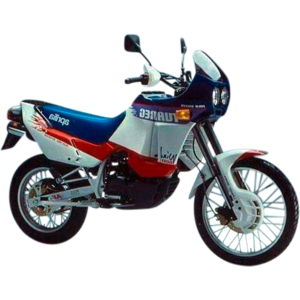Aprilia Tuareg 600 Wind (1987-1991): The Charismatic Thumper That Defies Expectations
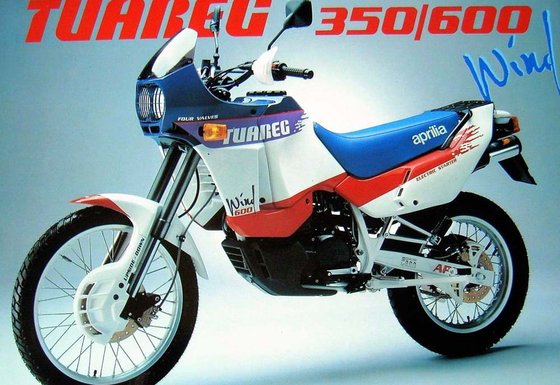
Introduction
The Aprilia Tuareg 600 Wind stands as a fascinating artifact of late-80s Italian motorcycle design—a machine that straddles the line between rugged enduro pretender and spirited road companion. Built between 1987 and 1991, this air-cooled single-cylinder adventurer carves out its niche with a blend of Rotax-engine grit, striking aesthetics, and a personality that oscillates between lovable and infuriating. After spending time with a well-worn 1990 example, it’s clear this bike isn’t just a relic—it’s a conversation starter that rewards those willing to embrace its quirks.
Design & Ergonomics: Tall, Bold, and Unapologetically Italian

At first glance, the Tuareg 600 Wind screams “adventure” with its high fenders, long-travel suspension, and upright riding position. The bodywork—prone to transit damage, as noted in period reviews—boasts a color palette that’s equal parts late-80s exuberance and functional simplicity. Our test bike wore a faded but still vibrant blue-and-white scheme, with Aprilia’s logo plastered proudly across the oversized fuel tank (18.4L / 4.9 US gal).
The 910mm (35.8") seat height is tall, even by modern ADV standards. Shorter riders will find themselves performing an awkward one-cheek shuffle at stops, but the payoff comes in commanding visibility on the road. Wide handlebars and neutral footpeg positioning create a comfortable triangle for all-day rides, though the narrow 21-inch front wheel feels more at home on gravel than carving asphalt.
Engine & Performance: The Rotax Heartbeat
Powering the Tuareg is a 562cc (34.3 cu in) Rotax single-cylinder engine—a lump that’s equal parts agricultural and charismatic. With 46 hp @ 7,100 rpm and a meaty 58 Nm (42.8 lb-ft) of torque peaking at 5,800 rpm, this air-cooled thumper delivers its power with a jovial disregard for refinement.
Key Characteristics:
- Low-End Grunt: The engine’s torque curve feels like a shovel digging into dirt—urgent and insistent. From 3,000 rpm onward, it pulls hard enough to loft the front wheel in first and second gears with minimal provocation.
- Vibration Symphony: Below 4,000 rpm, the Tuareg hums along pleasantly. Past 6,000 rpm? It transforms into a buzzing hive of tingling handlebars and footpegs. Not unpleasant, but you’ll know you’re riding a big single.
- Fuel Efficiency: Averaging 5.8 L/100 km (40.5 US mpg), the Tuareg’s range stretches to ~315 km (196 miles)—a figure that still impresses today.
The 6-speed transmission (a rarity among contemporaries) is a highlight, offering crisp shifts and a tall sixth gear that keeps vibrations manageable at highway speeds. Our test bike topped out at 155 km/h (96 mph), though sustaining that pace felt like asking a marathon runner to sprint indefinitely.
On-Road Manners: Better Than It Should Be

Don’t let the knobby tires and long-travel suspension fool you—the Tuareg 600 Wind harbors surprising road competence.
Strengths:
- Suspension Plushness: The 40mm front fork and adjustable monoshock (210mm/8.3" and 220mm/8.7" travel, respectively) swallow potholes and broken pavement with disdain.
- Steering Quirks: The narrow 90/90-21 front tire initially feels vague, especially when leaned over. Dropping the fork tubes by 25mm (1")—a common period mod—sharpened turn-in dramatically.
- Braking Surprises: The single 300mm front disc with a 2-piston caliper lacks initial bite but offers progressive stopping power. Aftermarket sintered pads would modernize feel.
During a spirited backroad blast, the Tuareg defied expectations. It leaned further than its trail-bike looks suggested, scraping pegs through corners while the Rotax engine churned out tractable power exits. The real revelation came on a tight circuit: lowered suspension transformed it into a giggle-inducing backroad scraper, though braking fade arrived quickly under repeated abuse.
Off-Road Limitations: Pose Over Performance
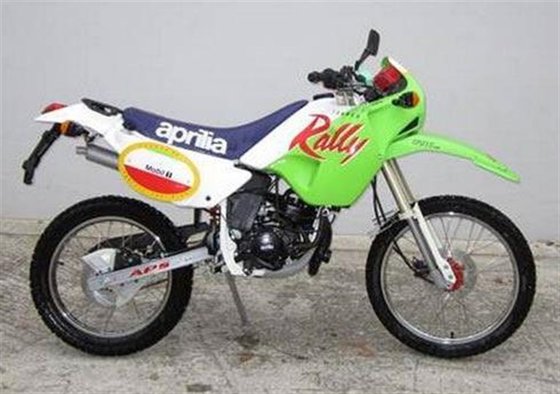
Aprilia marketed the Tuareg as a dual-sport, but this is where the facade cracks.
- Weight Distribution: At 168 kg (370 lbs) wet, the Tuareg feels top-heavy when the going gets loose. Stand-up riding exacerbates the issue, as the fuel tank’s mass sits high.
- Tire Troubles: The 21/18-inch wheel combo and period knobbies lack bite on technical terrain. Swapping to modern 50/50 tires (like the Mitas E-07) would help marginally.
- Seat Height Struggles: Dabbing a foot in tricky sections becomes a yoga exercise for riders under 180cm (5’11”).
In summary: competent on fire roads, outclassed by dedicated enduros.
Competition: How It Stacked Up
The late-80s/early-90s midweight ADV segment was a battlefield of singles and twins. Here’s how the Tuareg fared:
| Model | Engine | Power | Weight | Strengths | Weaknesses | |--------------------|----------------|-------|--------|-----------------------------------------|--------------------------------| | Aprilia Tuareg | 562cc Single | 46 hp | 168 kg | Torque, 6-speed, character | Off-road pretense, vague front | | Honda NX650 Dominator | 644cc Single | 48 hp | 181 kg | Reliability, low-end grunt | Heavy, agricultural handling | | Suzuki DR650 | 644cc Single | 50 hp | 166 kg | Off-road capability, simplicity | Basic road manners | | Aprilia Pegaso 600 | 562cc Single | 45 hp | 172 kg | Road-focused geometry, USD forks | Less torque, smaller fuel tank |
Key Takeaways:
- The Tuareg’s torque advantage over the Pegaso made it more entertaining on twisty roads.
- Against Japanese rivals, it traded off-road prowess for Italian flair and a superior transmission.
- Today, it’s the Rotax engine’s durability (and tunability) that keeps these bikes relevant.
Maintenance: Keeping the Tuareg Thriving
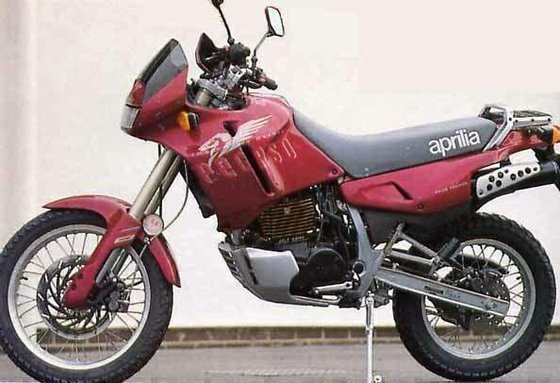
Owning a Tuareg 600 Wind requires mechanical sympathy and occasional parts hunting. Here’s what to prioritize:
Critical Service Items:
- Valve Adjustments: Every 6,000 km (3,730 mi).
- Intake: 0.05mm (0.002") / Exhaust: 0.10mm (0.004")
- Oil Changes: 2.4L (2.5 qts) with filter. Use 15W-40 mineral oil for period correctness.
- Carb Tuning: The Dell’Orto PHBR35BD carb benefits from modern ethanol-resistant seals.
- Chain & Sprockets: 17/40 tooth combo wears quickly—upgrade to an X-ring chain.
Common Upgrades:
- Tires: Swap to Pirelli MT60RS (100/90-19 front, 130/80-18 rear) for road-biased grip.
- Brakes: EBC HH sintered pads improve bite; stainless lines add feel.
- Suspension: Hyperpro springs correct fork dive; a rebuilt shock restores rear control.
MOTOPARTS.store Recommendations:
- Our Aprilia-specific valve shim kits simplify adjustments.
- Retrofit LED headlights (compatible with 12V systems) boost night visibility.
Conclusion: A Cult Classic Worth Revisiting
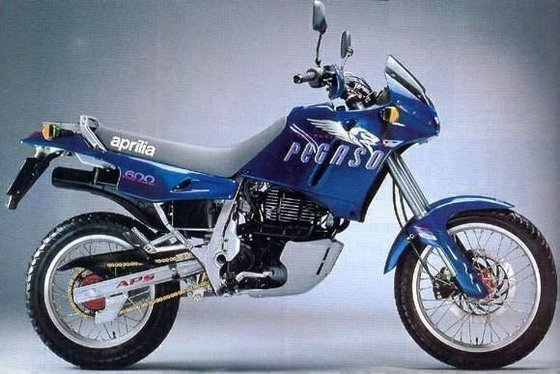
The Aprilia Tuareg 600 Wind isn’t the most practical or polished machine in the barn. Its off-road prowess is half-baked, its vibes are relentless at speed, and parts sourcing requires patience. Yet, it’s precisely these flaws—coupled with that glorious Rotax engine and cheeky Italian styling—that make it irresistible.
For riders seeking a vintage ADV with soul over sterility, the Tuareg delivers. With thoughtful upgrades (many available here at MOTOPARTS.store), this underdog transforms into a backroad charmer that’ll outgrin bikes twice its price. Just keep a toolkit handy—and maybe a cushion for those stoplight tiptoes.

Specifications sheet
| Engine | |
|---|---|
| Stroke: | Four-stroke |
| Ignition: | Nipponese electronic |
| Max power: | 34 kW | 46.0 hp |
| Max torque: | 58 Nm |
| Fuel system: | Dell'Orto PHBR35BD 35 mm carburetor |
| Lubrication: | Wet sump |
| Max power @: | 7100 rpm |
| Displacement: | 562 ccm |
| Max torque @: | 5800 rpm |
| Configuration: | Single |
| Cooling system: | Air-cooled |
| Compression ratio: | 9.4:1 |
| Number of cylinders: | 1 |
| Dimensions | |
|---|---|
| Dry weight: | 148 |
| Wet weight: | 168 |
| Seat height: | 910 mm (35.8 in) |
| Fuel tank capacity: | 18.4 L (4.9 US gal) |
| Drivetrain | |
|---|---|
| Final drive: | chain |
| Transmission: | 6-speed |
| Rear sprocket: | 40 |
| Front sprocket: | 17 |
| Maintenance | |
|---|---|
| Engine oil: | 15W40 |
| Idle speed: | 1400 rpm |
| Brake fluid: | DOT 4 |
| Spark plugs: | NGK D8EA, NGK DR8EIX |
| Forks oil type: | SAE 10W |
| Spark plug gap: | 0.6–0.7 mm |
| Forks oil capacity: | 1.06 |
| Engine oil capacity: | 2.4 |
| Engine oil change interval: | Every 5000 km or 2 years |
| Valve clearance (intake, cold): | 0.05 mm |
| Valve clearance (exhaust, cold): | 0.10 mm |
| Recommended tire pressure (rear): | 1.8 bar (26.1 psi) / 2.3 bar (33.4 psi) under load |
| Recommended tire pressure (front): | 1.7 bar (24.7 psi) / 2.0 bar (29.0 psi) under load |
| Chassis and Suspension | |
|---|---|
| Frame: | Steel tube |
| Rear tire: | 130/80-18 |
| Front tire: | 90/90-21 |
| Rear brakes: | Single 220 mm disc, 1-piston caliper |
| Front brakes: | Single 300 mm disc, 2-piston caliper |
| Rear suspension: | Monoshock with adjustable preload |
| Front suspension: | 40 mm telescopic fork |
| Rear wheel travel: | 220 mm (8.7 in) |
| Front wheel travel: | 210 mm (8.3 in) |



